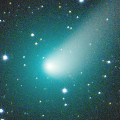
|
Now it is 8.1 mag (May 4, Seiichi Yoshida). It was expected to brighten up to 6-7 mag from April to July. But it is fainter than predicted recently. In the Northern Hemisphere, it stays observable in excellent condition until June. In the Southern Hemisphere, it stays extremely low for a while.
Date(TT) R.A. (2000) Decl. Delta r Elong. m1 Best Time(A, h)
May 6 15 42.70 42 2.4 0.964 1.712 120 7.3 0:49 (180, 83)
May 13 15 26.28 38 26.0 0.906 1.687 123 7.1 0:05 (180, 86)
|
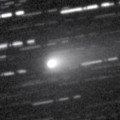
|
Outburst occured on Apr. 4, and it brightened by 2 mag, up to 6.2 mag (Apr. 7, Juan Jose Gonzalez). It is very bright as 7.0 mag still now (May 1, Yoshimi Nagai). It stays observable for a long time after this. But it locates low in the Northern Hemisphere.
Date(TT) R.A. (2000) Decl. Delta r Elong. m1 Best Time(A, h)
May 6 23 17.88 0 44.2 1.218 1.044 54 7.1 3:29 (279, 14)
May 13 23 47.43 4 7.1 1.253 1.043 53 7.2 3:20 (275, 14)
|
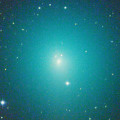
|
Now it is very bright as 7.0 mag (May 3, Juan Jose Gonzalez). It approached to Earth down to 0.14 a.u. from late March to early April. It is still very close to the Earth, around 0.2 a.u. It is observable in excellent condition in the Northern Hemisphere. It is observable in good condition after this also in the Southern Hemisphere.
Date(TT) R.A. (2000) Decl. Delta r Elong. m1 Best Time(A, h)
May 6 18 21.53 34 52.4 0.206 1.092 108 7.8 3:26 (180, 90)
May 13 18 28.93 28 53.8 0.227 1.123 114 8.4 3:06 ( 0, 84)
|

|
It has not been observed yet in this apparition. The condition of this apparition is worst. It will brighten up to 10 mag in spring, but not observable at all.
Date(TT) R.A. (2000) Decl. Delta r Elong. m1 Best Time(A, h)
May 6 3 21.27 16 4.2 2.081 1.087 7 10.9 20:24 (121,-13)
May 13 3 51.41 16 52.5 2.103 1.110 7 10.9 20:32 (122,-14)
|
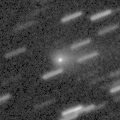
|
Now it is 12.0 mag (May 6, Marco Goiato). It is expected to brighten up to 10 mag in summer. It will be observable in excellent condition in the Southern Hemisphere. It locates low in the Northern Hemisphere.
Date(TT) R.A. (2000) Decl. Delta r Elong. m1 Best Time(A, h)
May 6 16 42.00 -20 58.1 0.706 1.671 153 11.4 1:47 ( 0, 34)
May 13 16 42.07 -22 29.4 0.665 1.652 160 11.2 1:20 ( 0, 33)
|
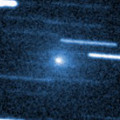
|
Now it is 11.0 mag (Apr. 28, Chris Wyatt). It stays 10-11 mag until May. It is not observable now in the Northern Hemisphere. In the Southern Hemisphere, it stays observable for a long time, but it stays low.
Date(TT) R.A. (2000) Decl. Delta r Elong. m1 Best Time(A, h)
May 6 0 37.81 2 9.6 1.639 1.013 35 11.7 3:29 (266, -1)
May 13 1 3.57 3 25.4 1.706 1.075 36 12.1 3:20 (264, -2)
|

|
Outburst occured on Apr. 23. Now it is bright as 12.5 mag (May 4, Seiichi Yoshida).
Date(TT) R.A. (2000) Decl. Delta r Elong. m1 Best Time(A, h)
May 6 21 36.67 -14 19.9 5.871 5.847 83 13.6 3:29 (308, 23)
May 13 21 38.78 -14 4.4 5.760 5.845 89 13.6 3:20 (312, 26)
|
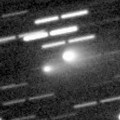
|
Now it is 12.3 mag (Apr. 5, Chris Wyatt). Bright new fragment BT was discovered on Feb. 10. Now the fragment BT is fainter than the primary component. In the Southern Hemisphere, it stays observable for a long time after this. In the Northern Hemisphere, it is not observable temporarily until mid June.
Date(TT) R.A. (2000) Decl. Delta r Elong. m1 Best Time(A, h)
May 6 0 20.91 -6 5.9 1.708 1.200 43 13.7 3:29 (275, -3)
May 13 0 40.75 -4 19.1 1.745 1.256 45 14.1 3:20 (274, -2)
|
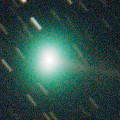
|
It brightened very rapidly, and brightened up to 6.3 mag (Apr. 2, Terry Lovejoy). However, the nucleus was disintegrated, and it is fading and getting diffuse rapidly after Apr. 9. It has already faded down to 10.5 mag (Apr. 19, Ken-ichi Kadota). It will not be observable after this.
Date(TT) R.A. (2000) Decl. Delta r Elong. m1 Best Time(A, h)
May 6 2 23.77 32 8.6 1.466 0.581 16 13.9 3:29 (227, -2)
May 13 2 49.21 28 44.7 1.630 0.679 12 15.1 3:20 (229, -6)
|
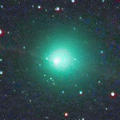
|
Now it is fading rapidly. It has already faded down to 12.3 mag (Apr. 28, Chris Wyatt). In the Southern Hemisphere, it stays observable in good condition after this while the comet will be fading. It locates low in the Northern Hemisphere.
Date(TT) R.A. (2000) Decl. Delta r Elong. m1 Best Time(A, h)
May 6 22 51.32 -17 8.0 1.176 1.231 68 14.1 3:29 (297, 8)
May 13 22 53.62 -17 3.0 1.187 1.334 74 14.6 3:20 (300, 11)
|
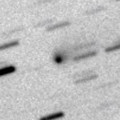
|
Now it is 14.7 mag (May 2, Catalina Sky Survey). It will brighten up to 14 mag from spring to summer. It locates somewhat low in the Northern Hemisphere. The perihelion distance increased from 2.4 a.u. to 2.9 a.u. in this apparition. So it will not be bright as before.
Date(TT) R.A. (2000) Decl. Delta r Elong. m1 Best Time(A, h)
May 6 16 22.19 -21 5.3 2.062 3.022 158 14.1 1:28 ( 0, 34)
May 13 16 17.54 -21 14.7 2.023 3.013 165 14.1 0:56 ( 0, 34)
|
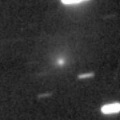
|
Now it is bright as 14.4 mag (Jan. 14, Thomas Lehmann). It is not observable now in the Northern Hemisphere. It will be unobservable temporarily in May also in the Southern Hemisphere. It will be getting higher gradually in the morning sky after summer. Then it will be observable at 11 mag for a long time from 2017 autumn to 2018 winter.
Date(TT) R.A. (2000) Decl. Delta r Elong. m1 Best Time(A, h)
May 6 3 41.31 -13 42.6 5.329 4.511 32 14.2 20:24 ( 93,-28)
May 13 3 47.56 -12 42.2 5.286 4.459 31 14.1 20:32 ( 98,-34)
|
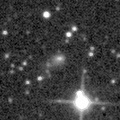
|
Now it is 14.7 mag (Apr. 22, Yuji Ohshima). It will be observable at 13 mag for a long time from 2017 to 2018.
Date(TT) R.A. (2000) Decl. Delta r Elong. m1 Best Time(A, h)
May 6 18 51.96 12 53.2 4.003 4.506 113 14.4 3:29 (342, 67)
May 13 18 45.02 14 27.3 3.887 4.473 119 14.3 3:20 (358, 69)
|
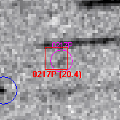
|
Now it is 15.9 mag (May 5, A. Maury, B. Sandness, T. Noel). It will brighten rapidly, and it is expected to brighten up to 12 mag from July to September. In the Southern Hemisphere, it stays at the same altitude in the morning sky. In the Northern Hemisphere, it will be getting higher slowly.
Date(TT) R.A. (2000) Decl. Delta r Elong. m1 Best Time(A, h)
May 6 23 19.84 -6 12.6 1.815 1.524 57 14.7 3:29 (284, 10)
May 13 23 43.31 -4 36.7 1.740 1.477 57 14.4 3:20 (283, 10)
|
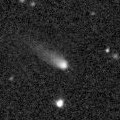
|
Now it is 15.6 mag (Feb. 15, Alexander Baransky). Appearing in the morning sky. It will brighten up to 12-13 mag and will be observable in good condition in summer.
Date(TT) R.A. (2000) Decl. Delta r Elong. m1 Best Time(A, h)
May 6 0 22.26 14 48.9 3.724 2.968 36 14.5 3:29 (258, 9)
May 13 0 22.36 15 4.3 3.607 2.940 42 14.4 3:20 (260, 13)
|
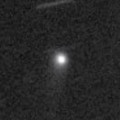
|
Appearing in the morning sky. In the Northern Hemisphere, it will brighten up to 14 mag from summer to next winter, and it will be observable in excellent condition. In the Southern Hemisphere, it will be observable in the very low sky only from May to June.
Date(TT) R.A. (2000) Decl. Delta r Elong. m1 Best Time(A, h)
May 6 0 12.30 22 32.2 4.183 3.444 37 15.0 3:29 (253, 15)
May 13 0 17.18 24 37.8 4.095 3.420 42 14.9 3:20 (253, 19)
|

|
Now it is 15.6 mag (Mar. 6, Kunihiro Shima). Now it is not observable. But it will appear in the morning sky in June in the Southern Hemisphere, or in July in the Northern Hemisphere. Then it stays observable at 15.5 mag unil the end of 2017.
Date(TT) R.A. (2000) Decl. Delta r Elong. m1 Best Time(A, h)
May 6 2 22.00 3 13.1 6.442 5.474 15 15.4 3:29 (249,-22)
May 13 2 28.30 3 33.4 6.440 5.497 19 15.4 3:20 (251,-19)
|
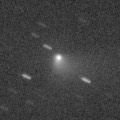
|
Small outburst occured in mid March, and it brightened up to 12.3 mag (Mar. 15, Juan Jose Gonzalez). Now it is fading. It has already faded down to 16.0 mag (Apr. 30, Catalina Sky Survey). It is observable in excellent condition in the Northern Hemisphere. It stays low in the Southern Hemisphere.
Date(TT) R.A. (2000) Decl. Delta r Elong. m1 Best Time(A, h)
May 6 11 30.77 26 29.9 2.103 2.689 114 15.6 20:33 ( 0, 81)
May 13 11 32.87 25 6.7 2.197 2.713 109 15.7 20:32 ( 29, 79)
|
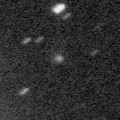
|
Now it is 16.2 mag (May 2, D. Buczynski). It is expected to brighten up to 9 mag in summer in 2018. In the Northern Hemisphere, it stays observable until 2018 summer while the comet will be brightening. In the Southern Hemisphere, it is hardly observable in 2017, but it will be observable in good condition in 2018.
Date(TT) R.A. (2000) Decl. Delta r Elong. m1 Best Time(A, h)
May 6 19 4.45 52 23.3 5.103 5.241 92 15.7 3:29 (199, 71)
May 13 18 59.61 52 59.2 5.009 5.184 94 15.6 3:20 (188, 72)
|

|
Now it is 15.3 mag (Apr. 23, Yuji Ohshima). It stays 16-17 mag for a long time from 2016 to 2019. It stays near by the equator.
Date(TT) R.A. (2000) Decl. Delta r Elong. m1 Best Time(A, h)
May 6 9 7.63 6 32.8 9.496 9.583 91 16.0 20:24 ( 55, 48)
May 13 9 9.10 6 42.4 9.606 9.580 85 16.0 20:32 ( 64, 42)
|

|
It brightened up to 11 mag from spring to summer in 2016. Now it is 17.2 mag (Apr. 30, T. Ikemura, H. Sato). It will be observable at 16-17 mag in good condition from spring to summer.
Date(TT) R.A. (2000) Decl. Delta r Elong. m1 Best Time(A, h)
May 6 20 30.94 -17 2.1 2.604 2.945 99 16.1 3:29 (324, 30)
May 13 20 32.94 -16 55.0 2.546 2.984 105 16.2 3:20 (329, 32)
|
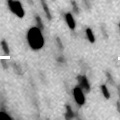
|
Now it is 16.1 mag (May 2, D. Buczynski). It was observed at 16 mag from spring to summer in 2016. It will be observable at 16 mag also in 2017 from winter to spring.
Date(TT) R.A. (2000) Decl. Delta r Elong. m1 Best Time(A, h)
May 6 18 27.32 16 3.8 2.933 3.517 117 16.3 3:29 (357, 71)
May 13 18 25.88 18 1.2 2.910 3.544 121 16.3 3:03 ( 0, 73)
|

|
Now it is 16.9 mag (Apr. 22, Yuji Ohshima). It stays observable at 16 mag until June. It locates low in the Southern Hemisphere.
Date(TT) R.A. (2000) Decl. Delta r Elong. m1 Best Time(A, h)
May 6 7 22.45 26 29.2 3.999 3.654 63 16.3 20:24 ( 98, 39)
May 13 7 29.96 26 13.1 4.081 3.648 58 16.3 20:32 (101, 33)
|

|
Now it is 16.8 mag (Apr. 7, MASTER-OAFA Observatory). It will brighten up to 15.5 mag in summer. It will be observable in excellent condition in the Southern Hemisphere. In the Northern Hemisphere, it stays unobservable for some more time.
Date(TT) R.A. (2000) Decl. Delta r Elong. m1 Best Time(A, h)
May 6 21 30.60 -42 33.0 2.319 2.596 94 16.5 3:29 (328, 2)
May 13 21 40.13 -41 47.4 2.226 2.575 98 16.3 3:20 (329, 3)
|
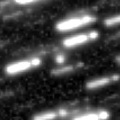
|
It was observed at 17 mag in 2016. In 2017, it will be observable at 15.5 mag in good condition from summer to autumn.
Date(TT) R.A. (2000) Decl. Delta r Elong. m1 Best Time(A, h)
May 6 0 6.80 -1 24.5 3.456 2.826 44 16.5 3:29 (274, 3)
May 13 0 16.27 -0 5.2 3.389 2.823 48 16.5 3:20 (274, 5)
|

|
It has not been recovered yet in this apparition. It will brighten rapidly, and it is expected to be observable at 15.5 mag in good condition from July to September.
Date(TT) R.A. (2000) Decl. Delta r Elong. m1 Best Time(A, h)
May 6 23 31.60 -21 38.1 2.883 2.571 62 16.7 3:29 (295, -2)
May 13 23 43.17 -20 31.3 2.807 2.562 65 16.5 3:20 (295, 0)
|

|
Now it is 15.7 mag (Apr. 23, D. Buczynski). It stays 16 mag from 2016 to 2017. In the Northern Hemisphere, it stays observable in good condition for a long time. In the Southern Hemisphere, it will never be observable again.
Date(TT) R.A. (2000) Decl. Delta r Elong. m1 Best Time(A, h)
May 6 19 3.42 57 56.8 6.252 6.325 89 16.6 3:29 (193, 66)
May 13 19 1.94 59 16.4 6.248 6.333 90 16.6 3:20 (186, 66)
|
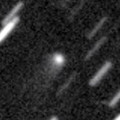
|
Now it is 16.3 mag (Apr. 28, T. Ikemura, H. Sato). It stays 16 mag for a long time from 2017 to 2018.
Date(TT) R.A. (2000) Decl. Delta r Elong. m1 Best Time(A, h)
May 6 8 15.65 9 31.8 5.643 5.534 78 16.7 20:24 ( 70, 41)
May 13 8 16.07 10 20.6 5.750 5.520 71 16.7 20:32 ( 78, 34)
|

|
It stayed bright 12 mag for a long time from autum in 2015 to summer in 2016. Now it is fading. It has already faded dwon to 16.1 mag (Apr. 29, T. Ikemura, H. Sato).
Date(TT) R.A. (2000) Decl. Delta r Elong. m1 Best Time(A, h)
May 6 16 57.72 -10 35.2 4.023 4.915 148 16.7 2:03 ( 0, 44)
May 13 16 51.37 -11 5.2 4.023 4.967 156 16.8 1:30 ( 0, 44)
|

|
It brightened up to 6.2 mag in June in 2016 (June 24, Marco Goiato). Now it is 16.7 mag (Apr. 30, K. Hills). In the Southern Hemisphee, it stays observable in excellent condition after this. It stays low in the Northern Hemisphere.
Date(TT) R.A. (2000) Decl. Delta r Elong. m1 Best Time(A, h)
May 6 12 57.99 -28 24.1 3.896 4.805 151 16.8 21:59 ( 0, 27)
May 13 12 50.15 -27 13.1 4.011 4.871 144 16.9 21:24 ( 0, 28)
|
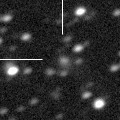
|
Now it is 17.2 mag (Apr. 30, P. Camilleri, H. Williams). In the Southern Hemisphere, it is observable at 17 mag in good condition in spring. It stays extremely low in the Northern Hemisphere.
Date(TT) R.A. (2000) Decl. Delta r Elong. m1 Best Time(A, h)
May 6 12 42.48 -39 44.8 5.077 5.918 143 17.3 21:44 ( 0, 15)
May 13 12 40.52 -38 27.2 5.106 5.917 140 17.3 21:15 ( 0, 17)
|
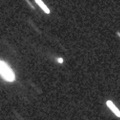
|
Now it is 16.3 mag (Apr. 30, T. Ikemura, H. Sato). It brightened rapidly, and became brighter than originally expected. It stays 16-17 mag until 2017. In the Northern Hemisphere, it stays observable in excellent condition for a long time. It is not observable in the Southern Hemisphere.
Date(TT) R.A. (2000) Decl. Delta r Elong. m1 Best Time(A, h)
May 6 11 35.76 58 0.1 7.315 7.477 95 17.3 20:38 (180, 67)
May 13 11 30.46 57 4.6 7.402 7.487 90 17.3 20:32 (170, 68)
|

|
Now it is 17.4 mag (Apr. 30, Thomas Lehmann). It was expected to brighten up to 12 mag in summer. But actually, it is fainter than expected by 3-4 mag. It is observable in excellent condition in the Southern Hemisphere. It locates somewhat low in the Northern Hemisphere.
Date(TT) R.A. (2000) Decl. Delta r Elong. m1 Best Time(A, h)
May 6 19 17.96 -33 21.3 1.593 2.254 118 17.6 3:29 (348, 21)
May 13 19 23.16 -33 19.1 1.504 2.230 123 17.3 3:20 (351, 21)
|
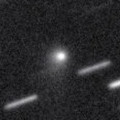
|
It brightened up to 15 mag in early 2016. Now it is fading. It has already faded down to 17.0 mag (Apr. 29, T. Ikemura, H. Sato). In the Northern Hemisphere, it stays observable in good condition for a long time until autumn when the comet will be fainter than 18 mag. It will never be observable after this in the Southern Hemisphere.
Date(TT) R.A. (2000) Decl. Delta r Elong. m1 Best Time(A, h)
May 6 14 6.78 70 49.4 6.587 6.705 92 17.4 23:07 (180, 54)
May 13 13 57.89 70 5.9 6.653 6.737 90 17.4 22:31 (180, 55)
|
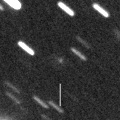
|
Now it is 16.3 mag (Apr. 30, T. Ikemura, H. Sato). It stays at 14 mag for a long time from 2018 to 2019. In the Northern Hemisphere, it stays observable in good condition while the comet will be brightening gradually. In the Southern Hemisphere, it is not observable until 2018 October.
Date(TT) R.A. (2000) Decl. Delta r Elong. m1 Best Time(A, h)
May 6 18 10.25 54 44.7 4.811 5.040 97 17.4 3:15 (180, 70)
May 13 18 1.09 56 21.9 4.747 4.988 97 17.4 2:39 (180, 69)
|
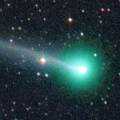
|
It approached to Earth down to 0.08 a.u. in mid February, and brightened up to 6.5 mag (Feb. 10, Danil Sidorko). Now it is fading rapidly. It has already faded down to 18.5 mag (Apr. 28, T. Ikemura, H. Sato).
Date(TT) R.A. (2000) Decl. Delta r Elong. m1 Best Time(A, h)
May 6 10 47.51 14 10.4 1.444 2.052 112 17.5 20:24 ( 22, 68)
May 13 10 53.09 13 11.3 1.597 2.128 107 17.9 20:32 ( 37, 64)
|
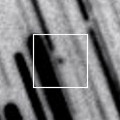
|
It will be observable at 17.5 mag in good condition from April to May. No observations have been reported recently.
Date(TT) R.A. (2000) Decl. Delta r Elong. m1 Best Time(A, h)
May 6 16 44.37 -12 45.0 1.582 2.520 152 17.5 1:51 ( 0, 42)
May 13 16 15.75 -14 20.0 1.561 2.553 165 17.5 0:55 ( 0, 41)
|

|
It has not been observed since last April. Now it is fading. But it must be bright as 17 mag still now.
Date(TT) R.A. (2000) Decl. Delta r Elong. m1 Best Time(A, h)
May 6 16 55.52 -16 38.9 2.595 3.508 150 17.5 2:01 ( 0, 38)
May 13 16 50.21 -16 12.4 2.620 3.578 158 17.6 1:28 ( 0, 39)
|
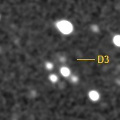
|
Now it is 16.6 mag (Apr. 29, T. Ikemura, H. Sato). It is observable at 17 mag in good condition in spring. It locates somewhat low in the Northern Hemisphere.
Date(TT) R.A. (2000) Decl. Delta r Elong. m1 Best Time(A, h)
May 6 12 9.44 -20 16.7 4.144 4.972 141 17.6 21:11 ( 0, 35)
May 13 12 4.26 -18 26.8 4.218 4.973 133 17.6 20:39 ( 0, 37)
|
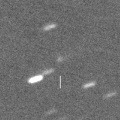
|
Now it is 17.0 mag (May 5, Mt. Lemmon Survey). It will be fainter than 18 mag in May.
Date(TT) R.A. (2000) Decl. Delta r Elong. m1 Best Time(A, h)
May 6 14 44.45 -10 58.7 1.564 2.569 174 17.8 23:46 ( 0, 44)
May 13 14 38.92 -10 53.9 1.595 2.591 167 18.0 23:13 ( 0, 44)
|
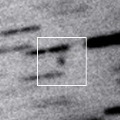
|
It stays observable at 18 mag from spring to summer. It is observable in excellent condition in the Southern Hemisphere. In the Northern Hemisphere, it stays unobservable for some more time.
Date(TT) R.A. (2000) Decl. Delta r Elong. m1 Best Time(A, h)
May 6 22 20.27 -34 26.0 5.328 5.285 82 17.9 3:29 (315, 1)
May 13 22 23.85 -34 13.5 5.249 5.303 87 17.8 3:20 (317, 4)
|
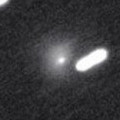
|
Very far object. Outburst occured on Feb. 20, 2015, and it brightened up to 15 mag. Now it is 18.0 mag (Apr. 29, T. Ikemura, H. Sato). It is observable in excellent condition in the Southern Hemisphere. It locates low in the Northern Hemisphere.
Date(TT) R.A. (2000) Decl. Delta r Elong. m1 Best Time(A, h)
May 6 14 30.36 -25 26.3 8.416 9.410 169 17.9 23:32 ( 0, 30)
May 13 14 28.39 -25 9.8 8.431 9.416 166 17.9 23:03 ( 0, 30)
|

|
It stays 15 mag from 2018 to 2019, and it will be observable for a long time in the Southern Hemisphere. In the Northern Hemisphere, it is observable only until June.
Date(TT) R.A. (2000) Decl. Delta r Elong. m1 Best Time(A, h)
May 6 12 7.41 -27 18.0 5.733 6.543 140 17.9 21:09 ( 0, 28)
May 13 12 4.27 -27 8.0 5.753 6.501 134 17.9 20:39 ( 0, 28)
|
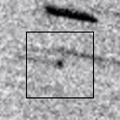
|
Although it was predicted to be fainter than 21 mag, an outburst occured and now it is very bright as 16.5 mag (May 1, T. Ikemura, H. Sato). It stays observable in good condition for a while.
Date(TT) R.A. (2000) Decl. Delta r Elong. m1 Best Time(A, h)
May 6 13 24.36 -20 0.6 2.305 3.266 158 17.9 22:26 ( 0, 35)
May 13 13 19.69 -19 19.2 2.382 3.307 151 18.4 21:54 ( 0, 36)
|
|
![]()
 71P/Clark
71P/Clark C/2017 E1 ( Borisov )
C/2017 E1 ( Borisov ) 29P/Schwassmann-Wachmann 1
29P/Schwassmann-Wachmann 1 73P/Schwassmann-Wachmann 3
73P/Schwassmann-Wachmann 3 C/2017 E4 ( Lovejoy )
C/2017 E4 ( Lovejoy ) 2P/Encke
2P/Encke 65P/Gunn
65P/Gunn C/2016 R2 ( PanSTARRS )
C/2016 R2 ( PanSTARRS ) C/2015 O1 ( PanSTARRS )
C/2015 O1 ( PanSTARRS ) 217P/LINEAR
217P/LINEAR C/2015 VL62 ( Lemmon-Yeung-PanSTARRS )
C/2015 VL62 ( Lemmon-Yeung-PanSTARRS ) C/2016 N4 ( MASTER )
C/2016 N4 ( MASTER ) C/2011 KP36 ( Spacewatch )
C/2011 KP36 ( Spacewatch ) 315P/2013 V6 ( LONEOS )
315P/2013 V6 ( LONEOS ) C/2016 M1 ( PanSTARRS )
C/2016 M1 ( PanSTARRS ) C/2014 B1 ( Schwartz )
C/2014 B1 ( Schwartz ) 81P/Wild 2
81P/Wild 2 C/2016 B1 ( NEOWISE )
C/2016 B1 ( NEOWISE ) 74P/Smirnova-Chernykh
74P/Smirnova-Chernykh C/2017 D2 ( Barros )
C/2017 D2 ( Barros ) 47P/Ashbrook-Jackson
47P/Ashbrook-Jackson P/2000 S1 ( Skiff )
P/2000 S1 ( Skiff ) C/2014 OE4 ( PanSTARRS )
C/2014 OE4 ( PanSTARRS ) C/2016 A1 ( PanSTARRS )
C/2016 A1 ( PanSTARRS ) C/2014 W2 ( PanSTARRS )
C/2014 W2 ( PanSTARRS ) C/2013 X1 ( PanSTARRS )
C/2013 X1 ( PanSTARRS ) C/2017 E3 ( PanSTARRS )
C/2017 E3 ( PanSTARRS ) C/2014 R3 ( PanSTARRS )
C/2014 R3 ( PanSTARRS ) 213P/Van Ness
213P/Van Ness C/2013 V4 ( Catalina )
C/2013 V4 ( Catalina ) C/2016 N6 ( PanSTARRS )
C/2016 N6 ( PanSTARRS ) 45P/Honda-Mrkos-Pajdusakova
45P/Honda-Mrkos-Pajdusakova C/2016 T1 ( Matheny )
C/2016 T1 ( Matheny ) C/2015 TQ209 ( LINEAR )
C/2015 TQ209 ( LINEAR ) C/2017 D3 ( ATLAS )
C/2017 D3 ( ATLAS ) 94P/Russell 4
94P/Russell 4 C/2015 H2 ( PanSTARRS )
C/2015 H2 ( PanSTARRS ) C/2013 C2 ( Tenagra )
C/2013 C2 ( Tenagra ) C/2017 B3 ( LINEAR )
C/2017 B3 ( LINEAR ) 157P/Tritton
157P/Tritton![]()







































